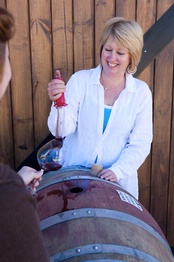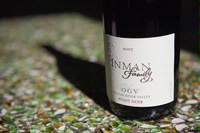Other winemakers call Kathleen Inman "The Barometer of Russian River Valley."
"I’m the first person to pick every year," Inman says. "I was doing an event in Chicago and Ed Kurtzman stood up and said, ‘When she picks, we know 10 days later it’s time to pick.’"
She’s not a proselytizer; you have to talk to her for a while before you learn the depth of her convictions about what makes a good wine. She’s  not into unusual varieties: She makes Pinot Noir, Chardonnay and Pinot Gris. She doesn’t make orange wines or no-sulfite wines or wines that taste weird.
not into unusual varieties: She makes Pinot Noir, Chardonnay and Pinot Gris. She doesn’t make orange wines or no-sulfite wines or wines that taste weird.
Because of this, she has managed to fly under the radar. But California sommeliers know who she is: One of the first people to make wines in the more restrained style that is quickly gaining popularity.
Example: Former Slanted Door sommelier Mark Ellenbogen stirred up the California wine industry when he famously refused to put any wines over 14% alcohol on his list.
"In 2004, Mark Ellenbogen called me and asked if I’d consider selling wine to the Slanted Door," Inman says. "Mine was the first California wine on the list and for a long time the only one."
Inman was born in Napa Valley, the fourth generation of a family of prune farmers. She was barely into wine until one night in 1982, when she took a blind wine tasting class in Santa Barbara with Doug Margerum.
"There were six wines, and when he pulled the bags off, three were from Napa," she says. " I thought, ‘These are where I’m from. That’s cool. We can make these’."
She got a jack-of-all-trades job at Napa Creek winery. On her first day, she was working in the tasting room when a British man walked in.
"He said his sister got married the night before," Inman says. "It was 11 a.m. It seemed weird to be on his sister’s honeymoon. I poured the wines and that was that.
"Two weeks later, we got a letter to Napa Creek Winery, no address, no zip code, addressed to the proprietor. ‘ Dear Proprietor: Please forward this letter to the pretty blonde who was working in the tasting room’."
They’ve now been married for 29 years.
Inman’s husband has been supportive while she built up the winery: 70 cases the first year, then 500, then 1800. She’s up to 4000 cases now and  says she’s one of the few winemakers at that production level to make wines the way she likes, rather than chasing a market.
says she’s one of the few winemakers at that production level to make wines the way she likes, rather than chasing a market.
"I think most wineries over about 3000 cases take their wines to Enologix and they try to use the right enzyme and the right methods to get the high score," Inman says.
The converse of that is the new emphasis on balance, low alcohol and natural production.
"So many people who were making wines in the big style are changing, and they’re the ones who are getting all the press," she says.
But Inman is as natural as any of them. She farms organically and has dropped vineyards that do not. She uses only native yeast and low sulfur (about 40 ppm) only at bottling.
She dropped one vineyard, Thorn Ridge Ranch, because she couldn’t convince the owner to stop pulling leaves, which she thought made the grapes get too concentrated.
"It’s my youngest daughter’s favorite wine. It’s great with short ribs," Inman says. "But it isn’t for my program."
Then there’s the compost. Inman gets deliveries of compost from San Francisco restaurants, including the Slanted Door, which gives the wines a nice circle-of-life feeling. She farms according to the cycles of the moon, but not biodynamically: "I don’t stir the compost tea for 60 minutes, then go the other way to insert chaos," she says. She uses compost as mulch under her vine rows to retard weed growth and also to impart nitrogen and beneficial bacteria to the soil.
"My friends tease me that my compost pile is visible from space," she says. "I have a guest house at the vineyard. The first year of the program, they didn’t send aged compost. My housekeeper said, ‘It smells like something died under the house’."
Fortunately for her guests, aged compost is less aromatic.
Inman started out making only Pinot Noir and Pinot Gris; she wasn’t excited about the Chardonnays she had tasted from the Russian River.
"In 2008 I was drinking my last bottle of Domaine Leflaive Montrachet," she says. "I thought, ‘I wish I hadn’t spent money on the winery, and I had more of this.’ My husband said, ‘Maybe you could make some.’ Well you can’t just make Leflaive Montrachet."
But she did find a vineyard she liked and, naturally, picked it earlier than everybody else. "I’m a grape groper," she says, gesturing in a somewhat obscene way. "When I like the way the grapes feel, and the flavors, I’m ready to pick."
That paid off in 2011, when she got her Chardonnay out of the vineyard three days before heavy rains that ignited botyrtis growth. Gary Farrell and Chateau St. Jean, among others that share the same vineyard, got no Chardonnay grapes from it in 2011, she says.
The most outstanding characteristic of her wines is the smooth mouthfeel. In fact, I remember rejecting a sommelier’s suggestion (at Aziza in San Francisco) that I have the entry-level Inman Russian River Valley Pinot Noir by the glass because his description — "it’s very smooth" — didn’t sound sexy enough.
But these are nice wines. In fact, I like the entry-level $35 wines, both Pinot Noir and Chardonnay, better than the $63 single-vineyard wines. Some of that smoothness comes from extra aging: Her current-release Pinots are 2009 vintage, with the 2010s due out later this year.
"There’s a lot of baggage with the term ‘natural winemaking’," Inman says. "I make these wines as honestly as I can."
